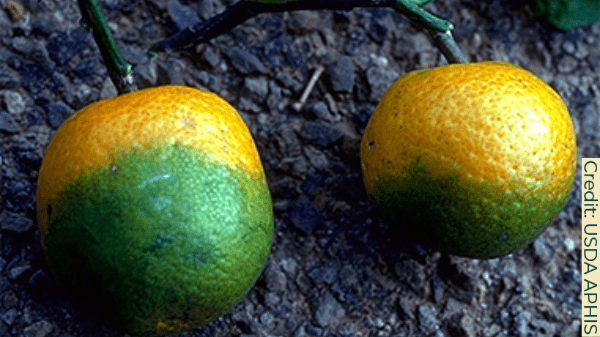The bacterial disease huanglongbing (aka HLB or citrus greening disease) has convulsed the world citrus industry.
Disturbing new statistics come out of Brazil. According to the research group Fundecitrus, the disease has now infected 38 percent of the nation’s citrus acreage.


One estimate says that the disease could reduce Brazil’s citrus production by 60 percent over the next five years.
HLB has already left its mark in the United States. Florida’s citrus bearing acreage has declined by around 50 percent since 2003-04. HLB cannot be blamed entirely for this attrition: other causes include a statewide canker eradication program in the late 1990s, hurricanes, and increased real estate development.
Citrus Acreage Attrition by County in Florida – Citrus Industry Magazine
So far, California’s principal citrus growing region—the southern San Joaquin Valley—has been spared the disease, with only scattered and isolated outbreaks in backyard trees.
Ventura County, a major lemon producing area, has not been so lucky. One infected tree was found in Santa Paula in October, requiring the California Department of Food and Agriculture, to impose a quarantine area within a five-mile radius of the infected tree. Fortunately, the infection was found in a backyard tree, but the orchards of lemon and avocado grower Chris Sayer are within that radius. Extra measures to ensure clean fruit may cost him between $300 and $700 per acre, which is beyond current citrus margins.
“This may put the thumb on the scale to retire the rest of our citrus acreage,” said Sayer.
Until very recently, there was no remedy for HLB: infected trees had to be pulled down. Present hope focuses on new treatment methods, such as injection of the antibiotic oxytetracycline (OTC) directly into tree trunks. But the method has associated risks: trunk injection could weaken the main columnar support of the tree.
Some growers, like Florida’s Wheeler Farms, have gone all in with trunk injection. Others have chosen to start with treatment on a limited number of trees beforehand.
Invaio, a bioplatform company, has introduced a less risky method. Its Trecise system injects the antibiotic via canister directly into the conductive tissues of the tree. The company lists advantages including a 90 percent decrease in the amount of antibiotic needed, shorter treatments, and (unlike better-known methods), elimination of the need for drilling, which makes it suitable for young and nonbearing trees.
Overall, treatments have led only to ambiguous success. In a recent newsletter, Highlands County Citrus Growers Association president Aaron Nelson wrote, “What I have seen with these different treatments on a purely observational level has been a mixed bag of results. While OTC has had an overall positive effect on tree health and thus far fruit drop, it has not performed consistently in every block. Canopy density and fruit retention are often very different in comparable groves. The differences have been hard to correlate to something concrete such as a rate or time of year.
“Learning what we can do better in year two of trunk injections is important but is complicated by the inconsistent results from block to block,” Nelson added.
“As usual, there are more questions than answers, but I am optimistic that we are building some momentum that we can carry into the future,” Nelson concluded.



